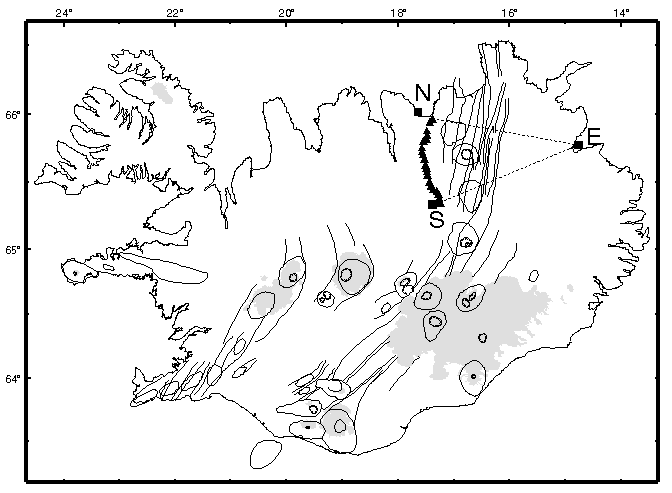
Part 3: Fan Shot Through NVZ

Fig 1: Map of iceland showing tectonic features, stations (triangles) of the B array and shots (squares). This section discusses the fan shot labeled E. (PostScript version of map).

Fig 2: Traveltime anomalies along the B array as a function of azimuth from the shot at Vopnafjordur. Raw data (circles). Corrected for near-receiver structure (triangles). (PostScript version of plot).

Fig 3: Corrected traveltime anomalies (left) and features of the neovolcanic zone (right). (IslandDraw and PostScript versions of plot).
Summary
Design. A single 150 kg shot at Vopnafjordur, off the NE coast of Iceland, was recorded by a NS striking array of seismometers located 125 km to the west. The compressional waves from this fan-shot pass through the Northern Neovolcanic Zone (NVZ) at a depth of about 10 km, allowing mid-crustal compressional velocity heterogeneties associated with plate boundary segmentation to be measured. The sampled part of the NVZ extends from the north coast at Husavik, through the Theistareykjabunga and Krafla central volcanoes, and ends at the northern edge of the Ketildynga central volcano.
Analysis of this shot began by picking traveltimes for each of the 23 stations of the B array. Seismograms were all bandpass filtered between 3 and 8 hz. Traveltimes were estimated by overlaying each vertical-component seismogram with the seismogram from a standard station (station b21), with the relative traveltime being the one which acheived the best correlation. The advantage to this method is that the whole wave packet (as contrasted to a first arrival) is used to determine the relative arrival time. The relative arrival times were converted to traveltimes by adding the first arrival time at station 21 (picked by eye) and by subtracting the origin time. These traveltimes were then normalized to a reference distance of 125.2 km by assuming a phase velocity of 6.8 km/s. This correction was small (<0.55 s), since the ranges of all the stations were similar (121.5-128.2 km).
Traveltime anomalies varying between -0.2 to 0.4 s occur. The velocity heterogeneities causing these anomalies could be occuring anywhere along the 125 km path from source to receiver. Since all rays left the same source in a small cone of angles, we assume that no traveltime anomaly occurs in the source region. We estimated the anomaly caused by near-receiver structure (i.e. along the 70+ km length of the B array), using the vertical traveltime through the 2D model of the upper-crustal structure beneath the B array described in Section 1. The corrections were relatively small (<0.15s). Of course, some signal could also arise from the part of the earth immediately to to east of the array. However, the pattern of fan-shot anomalies does not correlate well with the dome structure beneath the array. The two traveltime minima are at azimuths of 261 and 270 deg, corresponding to 29 and 50 km positions on the array. The 261 deg anomaly is at the same range as the southern dome in Part 1, but the 270 deg anomaly is at the same range as a velocity low between two domes. Sensitivity experiments (below) indicate that a feature must be at least 20-30 km wide in order to produce a traveltime anomaly of the observed amplitude. The domes have probably been truncated just to the east of the B96 array, during the rifting episode that created the NVZ. The source of the fan shot traveltime anomalies is more likely to be related to structures within the NVZ itself.
In the broadest terms, the traveltimes decrease from the north coast toward the Krafla region, and then increase again towards Ketildynga. The mid-crust beneath Krafla is faster than beneath either Theistareykjabunga or the northern part of Ketildynga. Two traveltime minima occur in the Krafla region, one at the azimuth corresponding to the northern edge of the central volcano, the other the the southern edge. However, detailed correspondences with tectonic features must be made only cautiously, because:
Supporting data
| name | location | size | lat | lon | depth |
| east shot | Vopnafjordur (fjord) | 150 kg | 65.774246 | -14.774520 | 0.03 |